CHAPTER ONE
INVESTIGATING THINGS IN THE ENVIRONMENT
KEY TERMS AND CONCEPTS.
- Air – this is a mixture of gases in the atmosphere
- Combustion-this is the combination of oxygen with another element.
- Photosynthesis- this is the process by which green plants make their own food by use of sunlight, carbon dioxide, water and chlorophyll
- Phototropisms- this is the process by which plant shoots grows towards light
- Hydrotropism- is the process by which plant roots are able to grow towards source of water.
- Crop rotation- this is planting different types of crops each season to prevent exhaustion of soil.
- Transipiration- this is the loss of water in form of water vapour from plants leaves.
- Soil- loose material found on the upper layer of the earth’s surface. Soil is a composition of water, mineral salts, living organism, particles and air.
- Soil texture- This is the smoothness or roughness of soil
- Capillarity- this is the ability of water to raise up in different soils
- Drainage- this is the ability of the soil to allow water to pass through it
- Soil erosion- is the removal of top fertile soil mainly by water and wind
- Mulching- act of spreading waste plant material over the ground to prevent soil erosion
- Terracing- cutting of steps across slopes to reduce speed of flow of water thus soil erosion.
Air is a mixture of gases. The gases that make the air include Nitrogen, Oxygen, . Carbon dioxide and Rare gases (also called inert gases or noble gases). Air is found in the atmosphere.
The table below summarizes the composition of air in the atmosphere.
| Gas | Percentage composition. |
| Nitrogen. | 78% |
| Oxygen | 21% |
| Rare gases or inert gases | 0.97% |
| Carbon dioxide | 0.03% |
Using a pie chart we can show composition of air as follows;
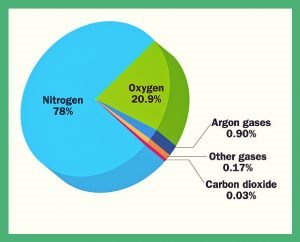
The different gases found in the air have different uses in our daily life. Below are some of their uses;
Uses of Nitrogen
- Manufacture of fertilizers: - nitrogen is used to make nitrogenous fertilizers which improve soil fertility for healthy plant growth.
- Protein synthesis: -nitrogen is used by leguminous plants such as beans, peas and groundnuts to make proteins which are necessary for proper plant growth. Leguminous plants have root nodules that contain nitrogen fixing bacteria that changes nitrogen gas into nitrates. The nitrates are needed to synthesize proteins. Examples of leguminous plants is beans and groundnuts.
Uses of Rare gases
Examples of rare gases are neon, argon, helium and krypton.
- Argon is used in filament bulbs for lighting and in welding.
- Helium is used in balloons, welding, in medical treatment and filled in air tanks used by divers to support them breathe under water.
- Neon is used in lights for billboards, diving equipment and lasers. Lasers are used for various purposes such as in surgery and in supermarkets paying counters for reading barcodes of items so that the price is known.
Uses of Oxygen
Burning - Oxygen supports burning (combustion). Burning of charcoal, gas
or wood provides heat for cooking. Burning of coal provides heat to run machines in industries. Burning of firewood or charcoal warm our bodies during cold weather. Burning of candle or firewood provides light.
Respiration - Oxygen is used during respiration in both animals and plants. Respiration plays a vital role of burning food to produce energy for living things.
Rusting - Oxygen combines with water and iron materials to form rust.
Seed germination - Oxygen is one of the necessary conditions for the seed germination.
Experiment : To show that oxygen is used in burning.
Materials: Two candles, clear glass
Procedure: Light the two candles. Cover one candle and leave the other uncovered. Observe what happens after a short time and record your observations.
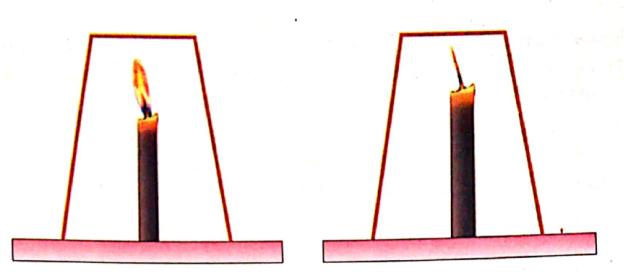
Figure to show that oxygen is used in burning.
Observation: The candle that is covered with a glass goes off after sometimes while the candle which was not covered continued to burn.
Conclusion and suggestions: The covered candle used all the oxygen in the glass for burning hence went off. The uncovered candle continued to burn because it had continous supply of oxygen from the atmosphere.
To show the percentage composition of oxygen in the air.
You need the following- A candle, water trough and a graduated glass jar.
Follow the procedure below-
Light the candle and put it in a glass jar of air inverted over water and arrange the materials as shown in the diagram below.

Diagram; To show percentage composition of Oxygen.
Observation:
- The candle goes off after sometime.
- The level of water in the trough goes down.
- Then water enters the glass jar.
Conclusion:
- The candle went off because all the oxygen in the glass was used up.
- Water entered the glass to occupy 1/5 of the space of the used up oxygen.
Uses of carbon dioxide
- Fire extinguishers: - because carbon dioxide does not support burning, it is used in fire extinguishers to put out fire.
- Food preservative:- carbon dioxide does not support life of the microorganisms, therefore is used in preservation of food and soft drinks to make them stay for a long time without going bad.
- Photosynthesis: - in presence of sunlight and water, carbon dioxide is used by plants to make their own food during the day by the process called photosynthesis.
- Solid carbon dioxide (often called 'dry ice') is used for freezing and keeping things frozen because of its low temperature going up to -78.5°C.
The essential needs for plants growth.
New plants need to grow to maturity. For the plants to grow well, they
need necessary conditions. Plants need oxygen, sunlight, carbon dioxide and nutrients.
Plants need oxygen
Plants are living things and oxygen is one of the essential needs for living things. Plants need oxygen all the time to carry out respiration. During the day, plants carry out photosynthesis giving out oxygen as a by-product. The plants use some of the oxygen for respiration and the excess oxygen is released to the atmosphere through the stomata.
Oxygen is important for plant growth because through respiration, energy is produced which helps in the absorption of nutrients and division of cells hence plant growth.
Plants need light
Light is used by plants to make food during photosynthesis. Some of the food is burned during respiration to release energy, while some is stored for future use such as during seed germination.
Experiment: To show that light is important for photosynthesis.
Materials: potted plants, light proof box and a knife.
Method: Make a small hole on the light proof box and place the potted plant in the box. Leave the set up for some few days. Make sure the plant has enough water.
Observation: What happens after a week? Record the observations.
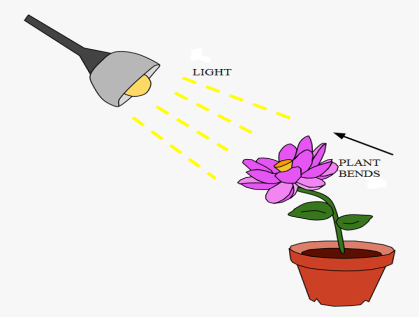
Phototropism in plants.
Plants need water
Water is very important for plants growth because it helps in transportation of nutrients in the plants. Water is also a raw material for photosynthesis.
Experiment: To show that water is essential for plants growth.
Materials: porous pot, waterproof trough and seedlings.
Methods: Arrange the setup as shown on the diagram by placing the seedlings at one end of the trough and a porous pot with water at the other end. Observations: Observe what happens after two to three days and record your observations.

Conclusion:
After a few days, the roots of the young plants bent towards the water. This aids plants to obtain water for growth. This action of plants roots growing towards water is called hydrotropism. Lack of water leads to death of plants: Some plants growing in dry areas have adaptive features to conserve water.
Adaptations of desert plants
Plant growing in dry areas adapt to their environment through the following ways:
Deep roots: - Roots of some desert plants penetrate very deep into the soil in search of water deep under the soil.
Shedding of leaves: - deciduous plants such as neem tree shed leaves to reduce water loss through transpiration. Transpiration is the loss of water through the stomata in the leaves.
Small or thorn- like leaves: - Desert plants e.g. cactus have thorn- like leaves and manufacture food with their succulent stems. Acacia plants have small leaves with thorns. This helps to conserve water through reduced transpiration.
Waxy cuticle- the stem of some desert plants are covered with a waxy shiny layer called cuticle. The cuticle prevents loss of water through transpiration.
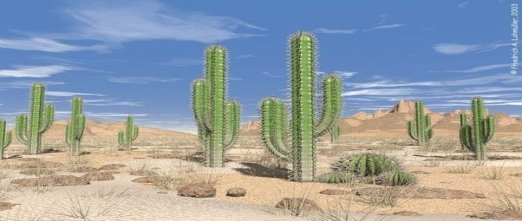
(a)

(b)
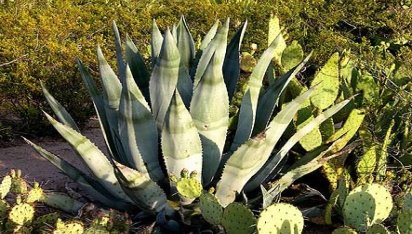
(c)
(d) Plants need carbon dioxide
Carbon dioxide is used by green plants during photosynthesis. The plants carbon dioxide from the atmosphere and also from respiration. Note that plants take in carbon dioxide during the day time only to manufacture food.
Plants need nutrients.
Plants needs nutrients to grow well. Fertile soils provide plants with the necessary nutrients for growth. If soil lacks nutrients, plants will not grow well. As plants continue to draw nutrients from the soil, the nutrients decrease and if not replaced, the soil become exhausted. The following are methods of maintaining soil fertility.
Crop rotation. - Planting different types of crops each season prevents exhaustion of nutrients.
Adding organic manure - animal dung and plant waste are the best natural fertilizers which make the soil fertile.
Planting leguminous - plants increase nitrates to the soil.
Addition of chemical fertilizers -chemical fertilizers add nutrients to the soil. However, long use destroy soil quality hence poor plant growth.
Some plants like Pitcher plants have distinctive adaptations for living in nutrient-poor soils and feed on insects to obtain the vital nitrogen that they need to grow. These plants are called carnivorous plants or insectivorous plants.
Photosynthesis
Photosynthesis is the process by which green plants manufacture their own food from water and carbon dioxide in the presence of sunlight. In this topic we are going to observe closely the parts involved in photosynthesis.
External parts of a leaf and their functions
A leaf is a very important part of a plant because in most plants, photosynthesis takes place in leaves.
![]() Experiment: To investigate the external parts of a leaf.
Experiment: To investigate the external parts of a leaf.
Requirements-Green leaves, exercise books, pens.
Procedure- Detach different green leaves from different plants and observe the external parts. Draw and label all the parts you can see.
Identify the following parts in your leaf; lamina, midrib, petiole, side veins, margin and apex and compare your leaf with the diagram below. Observe the texture of the upper and lower parts.

Conclussion.
The lamina of the leaf is the green part. The color is due to presence of chlorophyll chemical pigment which helps to trap sunlight for photosynthesis. The upper part of the leaf is shiny and smooth to trap sunlight, but the lower part is rough. The stomata distribution depends on the habitat of the plant.
The main external parts of a leaf and their functions are as follows;
- Petiole: this is the part that attaches the leaf to the stem
- Veins: they help in transportation of materials within the leaf
- Mid rib: it is the main vein that takes food from the leaf towards the other parts of the plant.
- Lamina: attaches the leaf to the stem.
The internal parts of a leaf.
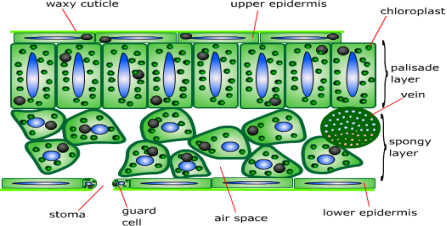
Functions of the internal parts of a leaf
- Cuticle: It is a waxy transparent waterproof layer found on bothsides of the leaf. It protects the inner tissue against damage.
- Stomata:Tiny poress on the side of the leaf that allows gases to enter and leave the Ieaf.They also allow transpiration to take place.
- Guard cells: The cells surrounding the stomata which controls opening and closing of stomata.
- Epidermis: The outer thin later below the cuticle found on both sides of the leaf. The cuticle is made from epidermis.
- Vascular bundles : The vascular bundles consists of xylem and phloem tissues. The xylem vessels transport water and mineral salts while phloem tissues transport manufactured food from the leaves and storage organs to all parts of the plant.
- Chloroplasts- Chloroplasts are organelles that contain chlorophyll.
Chlorophyll traps sunlight energy which is needed for photosynthesis.
Conditions necessary for photosynthesis
- Carbon dioxide : Carbon dioxide is a raw material for photosynthesis process. It enters the leaf through stomata.
- Water :Water is used as a raw material for photosynthesis. It is absorbed from the soil by roots.
- Chlorophyll : Chlorophyll traps light energy necessary for the process of
photosynthesis. - Light energy : light energy is obtained from the Sun. Light energy in the
presence of chlorophyll converts water and carbon dioxide into starch, water and oxygen.
End products of photosynthesis
The end products of photosynthesis are oxygen glucose and water. Part of the oxygen is used by plants during respiration and the excess is released to the atmosphere. Glucose is use by plants during respiration to release energy and excess is converted into starch or oils, and stated m the storage parts of the plant such as stems or roots. The water produced is used by the plant and excess released to the atmosphere through respiration.
Importance of photosynthesis.
- It produces food for other living organisms
- Help in maintaining balance of atmospheric gases
- Produces oxygen which is used by other organism for photosynthesis
Soil.
Soil – This is the loose material found on the upper layer of the earths surface . Soil is composed of water, humus, living organisms mineral particles and air.
Activity:To investigate the composition of soil.
Materials:soil, transparent glass and water.
Procedure: Put the sample of soil in the transparent glass, add some water and shake gently. Leave the contents to settle and record your observations.
Observations: the soil forms distinct layers with gravel remaining at the bottom.
Conclusion: soil is made up of different layers. The arrangement of the soil in layers from top to bottom is called soil profile.
This is as shown below;
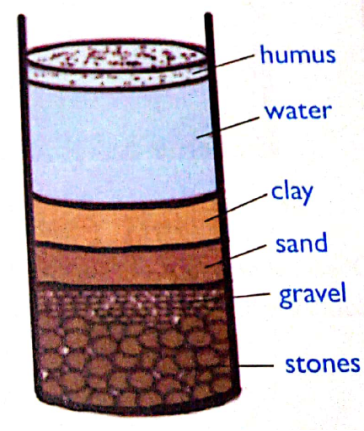
We can show that soil contains air as follows;
- Put dry soil in a glass of water. Then add water to the soil and observe what happens. You will find that bubbles of air will be escaping from the soil after adding water. This shows that soil contains air.
Types of soils.
There are three types of soils;
- Clay soil
- Loam soil
- Sand soil
The physical properties of soil includes, soil texture, soil capillarity and soil drainage.
Soil texture.
This is the smoothness or roughness of the soil. Different soils have different textures; for example
- Clay soil has smooth texture because of small particles
- Sand soil has rough texture because of large particles
- Loam soil has moderate structure
Capillarity.
This is the ability of water to raise up in different soils. Cappilarity of a given soil depends on the size of its particles. Soil with small particles has the highest capillarity while soil with big particles has the lowest capillarity. Among the three soils, clay soil has the highest capillarity while sand soil has lowest capillarity.
Drainage.
This is the ability of soil to allow water to pass through. Like capillaruty, drainage is determined by the size of particles. Sand soil has the highest drainage because of large particles while clay soil has the lowest drainage because of small particles.
The general characteristics of the three soil types are as follows;
Characteristics of clay soil
- It has small particles.
- It has the lowest drainage and it is easy y wa:erioLged.
- It has the highest capillarity.
- It has a smooth texture.
- It is sticky and can be used in modelling
Characteristic of sand soil
- It has big particles.
- It has the highest drainage.
- It has the lowest capillarity.
- Sandy soil has a rough texture.
- Sandy soil is good for building and construction purposes.
Characteristics of loam soil
- Loam soil is a mixture of sand, clay and humus.
- Its particles are medium sized
- It has medium drainage.
- Loam soil has medium texture.
- Loam toil is good for farming
Soil erosion.
Soil erosion is the carrying away of the top fertile soil mainly by water and wind. Things which contribute to soil erosion in one way or the other are called agents of soil erosion.These agents include wind, rain (water), human beings and animals
When it is raining, the rain drops make the soil loose and easily carried away by the flowing water. On the other hand, when strong winds blow over bare soils, it carries away the top fertile soil, depositing it to another place. Animals and human activities like deforestation and cultivation make the soil loose and bare, accelerating the rate of soil erosion.
The rate at which the soil is eroded depends on different factors as explained below.
Factors that increase the rate of soil erosion
- Steepness of the land: Soil is easily eroded by running water on a sloppy land than on a gentle slope or flat land.
- Type of soil: Sandy sods are easily carried away than loam and clay soils.
- Bare soils are easily carried away by both wind and water than soils with vegetation cover.
- Human activities like poor farming methods. mining, road construction, building and deforestation. Some of the poor farming methods include overgrazing and ploughing along the slope.
Ways of controlling soil erosion
1. Cover Methods
These methods all protect the soil from the damaging effects of rain-drop impact. Most will also improve soil fertility.
Mulching
Bare soil between growing plants is covered with a layer of organic matter such as straw, grasses, leaves and rice husks - anything readily available. Mulching also keeps the soil moist, reduces weeding, keeps the soil cool and adds organic matter. If termites are a problem, keep the mulch away from the stems of crops.
Cover crops and green manures
Cover crops are a kind of living mulch. They are plants - usually legumes - which are grown to cover the soil, also reducing weeds. Sometimes they are grown under fruit trees or taller, slow maturing crops. Sometimes they also produce food or fodder. Cowpeas, for example may be used both as a cover crop and a food crop.
Green manures - also usually legumes - are planted specially to improve soil fertility by returning fresh leafy material to the soil. They may be plants that are grown for 1-2 months between harvesting one crop and planting the next. The leaves may be cut and left on the surface of the soil as a mulch or the whole plant dug into the soil. Green manures may also be trees or hedges which may grow for many years in a cropping field from which green leaves are regularly cut for use as mulch (alley cropping).
Mixed cropping and inter-cropping
By growing a variety of crops - perhaps mixed together, in alternate rows, or sown at different times - the soil is better protected from rain splash.
Early planting
The period at the beginning of the rainy season when the soil is prepared for planting, is when the damage from rain splash is often worst. Sowing early will make the period when the soil is bare, as short as possible.
Crop residues
After harvest, unless the next crop is to be immediately replanted, it is a good idea to leave the stalks, stems and leaves of the crop just harvested, lying on the soil. They will give some cover protection until the next crop develops.
Agroforestry
Planting trees among agricultural crops helps to protect the soil from erosion, particularly after crops are harvested. The trees will give some protection from rain splash. Fruit, trees, legume trees for fodder or firewood and alley cropping all help reduce soil erosion.
Minimum cultivation
Each time the soil is dug or ploughed, it is exposed to erosion. In some soils it may be possible to sow crops without ploughing or digging, ideally among the crop residue from the previous crop. This is most likely to be possible in a loose soil with plenty of organic matter.
2. Barrier Methods
Barrier methods all slow the flow of water down a slope. This greatly reduces the amount of soil which run-off water can carry away and conserves water. Any kind of barrier should work. To be effective any barrier must follow the contour lines.
Man-made terraces
In some countries terracing has been successfully practised for centuries - the Philippines, Peru and Nepal, for example. Well-built terraces are one of the most effective methods of controlling soil erosion, especially on steep slopes. However, terraces require skill and very hard work to build. Each terrace is levelled - first by levelling the sub-soil, then the top soil - and firm side supports are built, often of rock. Man-made terraces are unlikely to be an appropriate method in countries with no tradition of terrace building.
Contour ploughing
Whenever possible all land should be ploughed along the contour line - never up and down, since this simply encourages erosion. In some cultures this may be very difficult due to the pattern of land inheritance. For example the Luo people in Western Kenya inherit land in long strips running down to the river valleys, making contour ploughing extremely difficult. Soil conservation programmes may need to consider land redistribution schemes, or neighbouring farmers will have to work together.
CHAPTER SUMMARY.
- Air is a mixture of gases in the atmosphere
- Air consists of gases such as oxygen, carbon dioxide nitrogen and rare gases
- The active part of air is oxygen because it supports combustion
- Nitrogen is less reactive and thus dilutes oxygen in the atmosphere
- Oxygen occupies 21% of the atmospheric air
- Oxygen supports life because it is used in respiration
- Carbon dioxide can be identified by its ability to turn lime water milky
- For proper growth, plants needs oxygen, sunlight, carbon dioxide and nutrients.
- Plant growth towards light is called phototropism
- Plant growth of roots towards water is called hydrotropism
- Plants have certain adaptations for growth in various areas
- Desert plants have deep roots, ability to shade leaves, small or thorny leaves and waxy-cuticle.
- Some plants which grows in soil without nitrogen feeds on insects and are called insectivorous plants.
- Plant make own food by a process called photosynthesis
- Soil is the loose material found on the upper surface of earth’s surface
- There are three types of soil, clay loam and sand soil
- The main properties of soil includes, drainage, capillarity, and soil texture
- The removal of top fertile soil by agents such as water and wind is called soil erosion.
www.learninghubtz.co.tz
Hub App
 For Call,Sms&WhatsApp: 255769929722 / 255754805256
For Call,Sms&WhatsApp: 255769929722 / 255754805256
 For Call,Sms&WhatsApp: 255769929722 / 255754805256
For Call,Sms&WhatsApp: 255769929722 / 255754805256
WHATSAPP US NOW FOR ANY QUERY
App Ya Learning Hub Tanzania






